  
Western Body & Hoist Company
Western Shu-Pak
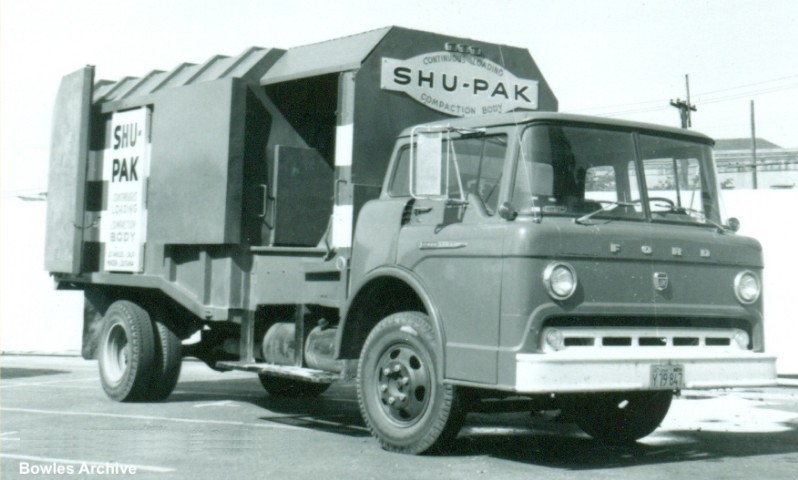
An early Shu-Pak demonstrator unit from the 1960s on a straight-frame Ford cabover
Shortly after the aquistion of A&P Body, Western Body & Hoist entered into a licensing agreement with inventors John & Peter Shubin of San Pedro, California to build a radical new body the brothers had designed. This was a side loader, based on the Hyde-Pak design, but with some new features. A partial-packer with tilt-to-dump unloading, the Shu-Pak had a much smaller hopper and packer blade, which continuously swept small batches rearward into the body passage. As built, the hopper was lower than the body, which required cutting and lowering the truck chassis at its midsection. Refuse was pushed through the hopper and up an incline to body floor level. The low loading height was unprecedented in refuse truck design, and most Shu-Paks were built as "one man" refuse trucks, with walk-in cabs and right-hand or dual controls.
With the Shu-Pak, Western Body & Hoist was on the forefront of an all-new concept in refuse collection practice, eliminating the loading crew that traditionally accompanied the driver. The driver simply walked out of the cab at curbside, taking only a few steps to toss refuse in to the hopper at about waist-level. The shallow packer blade constantly swept the load into the body, which was far lighter and simpler than most rear loaders, while delivering larger legal payloads. This type of refuse truck would soon dominate in residential collection fleets in California and much of the west.
The Shu-Pak did face competition, and from the company that was by then battling Western Body & Hoist for market supremacy, the S. Vincen Bowles Company. Bowles had developed a nearly identical packer as early as 1958, called the Load-n-Pack. Like the front loading refuse truck, the Load-n-Pack and the Shu-Pak were similar designs developed almost simultaneously by different companies. The Shubins, however, were first in the patent race, and pursued litigation which proved to be costly to both companies. A kind of truce was reach by 1963, in which Bowles continued to build side loaders, but agreed not sell them in southern California. It would seem there was more than enough of the pie to go around in those golden days of the early 1960s refuse body business.
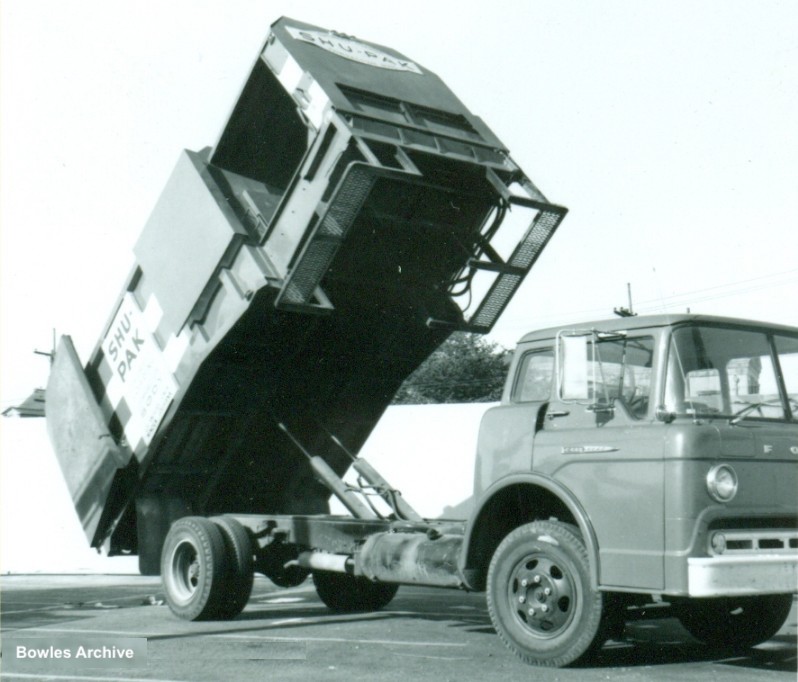
This early-model has a unitized body and hopper, in which the complete assembly tilts to dump
The Shu-Pak packing method was a departure from the typical side loading packers of the day, such as the Pak-Mor, Marion and E-Z Pack. These used full-travel blades which compressed the entire load at infrequent intervals, until the body was loaded. By contrast, the Shu-Pak pushed very small batches of refuse into the body almost constantly, with a 12" tall blade. The shallow body opening acted as a load retainer, and compaction didn't occur until the space within the body was completely filled. The reduced stresses of this method allow the body to be made lighter, and thus often carried larger legal loads than conventional packers. The hydraulic system was simpler, resulting in lower maintenance costs as well.
Despite the small size of the hopper, refuse could be loaded even as the packer blade was in motion, thanks to a follower plate which prevented material from spilling over the back side of the blade. The operator could load refuse at any time, regardless of packer position, as long as there room in the hopper. This so-called "inverted drawer" packer dated back to the earliest European compaction bodies built in 1930s by Fernand Rey and Jacob Ochsner. It could be cycled intermittently during periods of light loading, or continuously on denser routes. An optional "crusher" panel was often fitted to the front wall of the body, to tamp-down bulkier loads (such as cardboard boxes and brush) that would clog the hopper.
INSIDE THE SHU-PAK
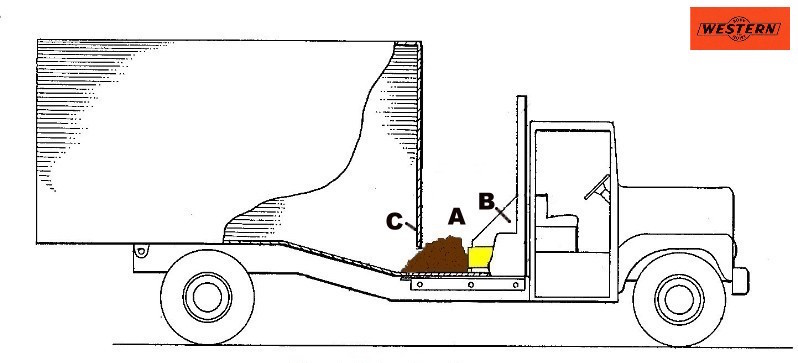 Refuse is loaded in the hopper (A), just behind the vehicle cab. The packer blade (yellow highlight) is in the retracted position, its follower plate concealed under the front bulkhead (B). A small opening in the front wall (C) of the body leads to and inclined passage into the body.
Refuse is loaded in the hopper (A), just behind the vehicle cab. The packer blade (yellow highlight) is in the retracted position, its follower plate concealed under the front bulkhead (B). A small opening in the front wall (C) of the body leads to and inclined passage into the body.
|
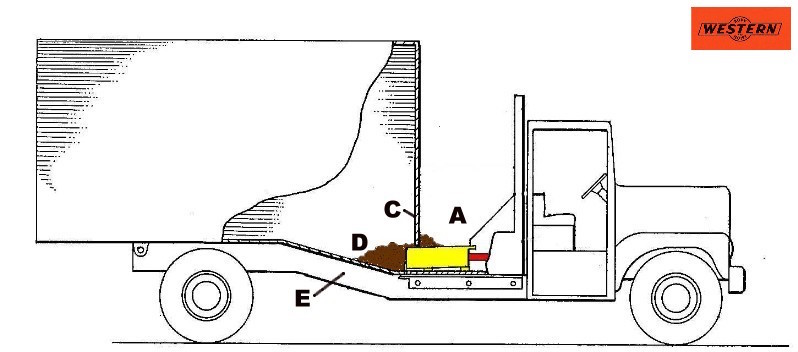
The packer blade moves rearward, powered by hydraulic rams, pushing the refuse through the opening and up the incline (D). It travels just far enough to clear the hopper (A), before retracting and then repeating the cycle. Subsequent batches of refuse move the load deeper into the body, with a churning action and light compaction once the body fills up.
Any refuse that falls behind the packer blade face as it enters the body (C) will land on the integrated follower plate, and falls back in front of the blade during the next cycle. Incoming refuse can also be dumped directly on the follower at any point during the cycle. To allow for the low-loading hopper, the vehicle frame rails are cut and lowered from behind the cab, to a point near the front of the body (E).
|
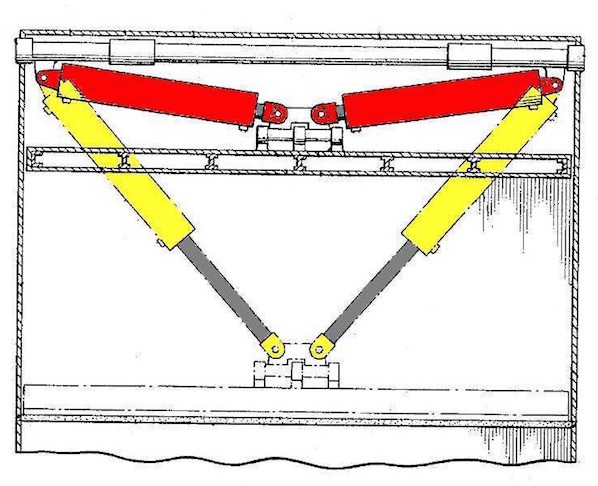 Overhead view of the packer plate (with the top follower plate removed) shows opposed 4" diameter hydraulic cylinders. Red highlights show retracted position, and yellow highlights indicate position of cylinders fully extended during pack cycle. This arrangement allows for a compact mechanism, without cylinder protrusion which would have crowded the hopper area. The early Shubin patent described a straight-thrust cylinder arrangement with the rams mounted under the truck cab, which was obviously impractical. Most modern side and front loaders use a variation of this method, except with the cylinders crossed over each over, increasing the maximum possible stroke.
Overhead view of the packer plate (with the top follower plate removed) shows opposed 4" diameter hydraulic cylinders. Red highlights show retracted position, and yellow highlights indicate position of cylinders fully extended during pack cycle. This arrangement allows for a compact mechanism, without cylinder protrusion which would have crowded the hopper area. The early Shubin patent described a straight-thrust cylinder arrangement with the rams mounted under the truck cab, which was obviously impractical. Most modern side and front loaders use a variation of this method, except with the cylinders crossed over each over, increasing the maximum possible stroke.
|
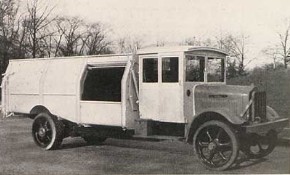
Drop-Frame side loaders had been built well before the Shu-Pak, such as this White with a non-compacting, enclosed refuse body. A low, spacious hopper could be heaped with refuse from several stops. When the hopper area was full, the body was tilted (using the underbody hoist normally used for dumping) to consolidate the refuse towards the rear section. This truck was part of an order for 774 units delivered to the Department of Sanitation, New York City (DSNY) in 1932.
|
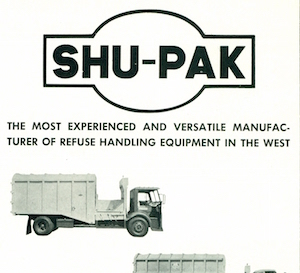
An early Shu-Pak trade ad, circa early 1960s, from the S.Vincen Bowles Photo Archive (courtesy of Zachary Geroux).
Click on image to enlarge ad.
|
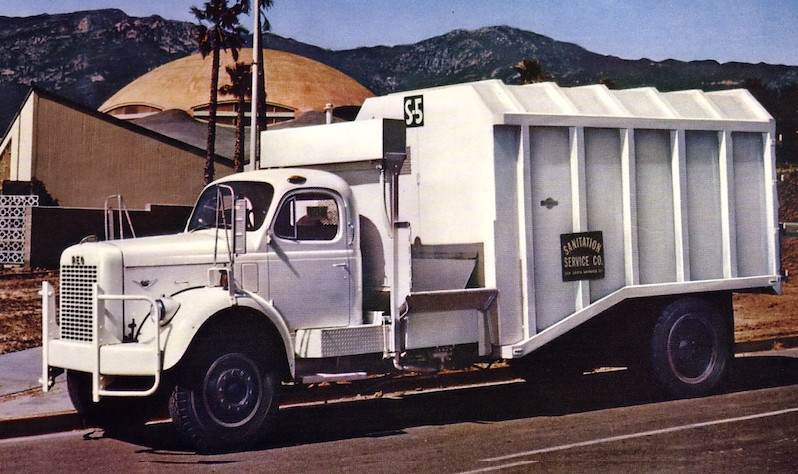
Sanitation Service Company of Santa Barbara switched from Bowles Load-n-Pack to the Western Shu-Pak in 1960
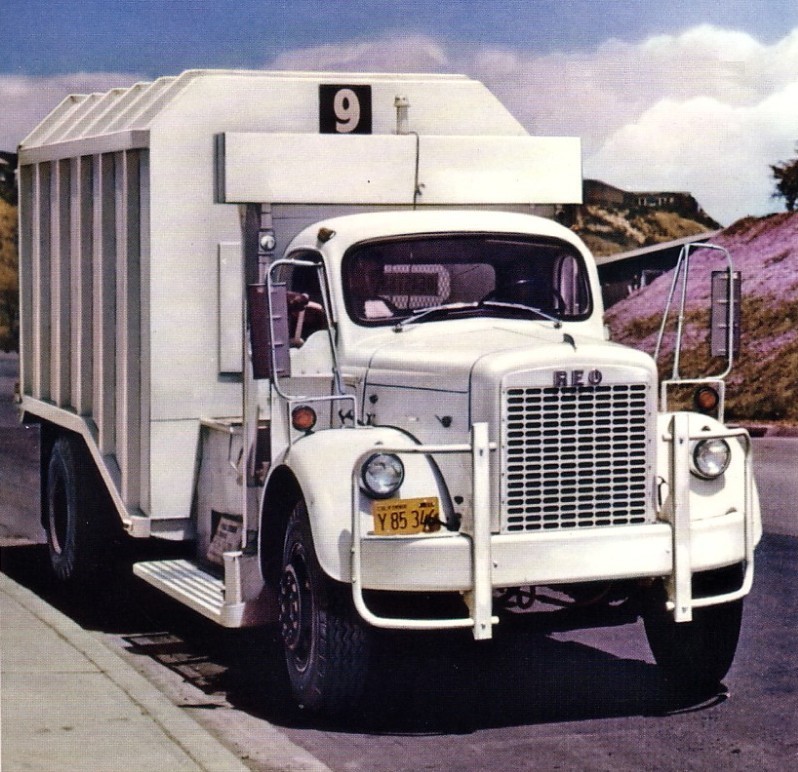
Sanitation Service Company Shu-Pak is mounted on a Reo C 402L modified with a drop-frame behind the cab
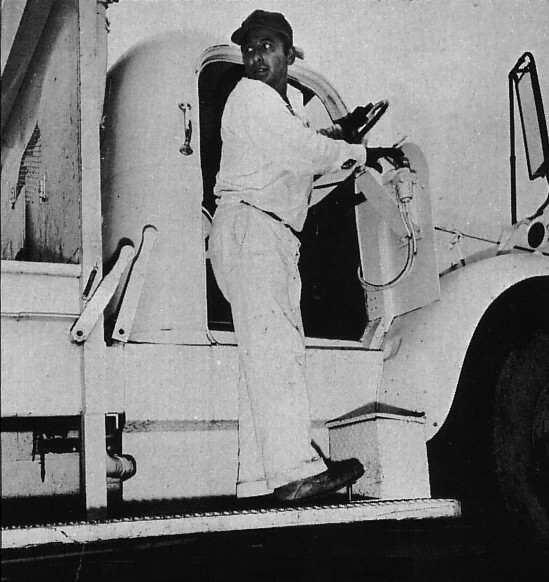
This Shu-Pak operator for Sanitation Service Company drives from a standing position on the running board, outside of the modified Reo cab, with the passenger-side door removed. In later years, better enclosure was provided to protect the driver from inclement weather.
Operators had but a few easy steps to the curb, a low pitch into the hopper, and then on to the next stop. Packer controls are seen just behind the cab.
|

Between 1960 and 1963, the City of Inglewood, California converted its entire fleet from 2-man/20-yard rear loaders to 1-man/37-yard side loaders. The sanitation departmen was so pleased with the results, they wrote an 8-page endorsement for Shu-Pak detailing their experiences. The most telling statistic was a 55-percent reduction in man-hours/per ton collected between 1960 and 1971, while the city population increased by 42-percent over the same period.
|
MURCOLE / COMPTON DISPOSAL

Murcole/Compton Disposal contracted to collect residential refuse in the city of Compton for the better part of 40 years. This photo shows what was likely their original fleet of Shu-Paks, on 1960 Chevrolet tilt-cabs with V-8 engines and RHD conversion. This was probably a GM fleet purchase, since a pair of Chevy Corvair sedans are also used for supervisors.
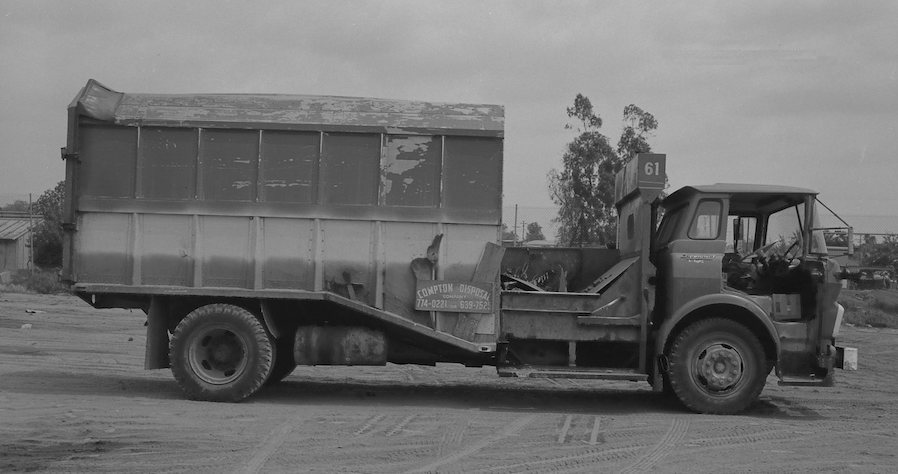
Truck 61 of the Compton Disposal fleet after about five years of hard service. These new side loaders quickly became a favorite of California municipalities and contractors alike because of their inherent economy. A 29-yard Shu-Pak body weighed in at a mere 7,400 pounds, or about half the weight of a Leach 2-R Packmaster body. Thus, the low-compaction Shu-Pak could typically carry more refuse legally than a comparably-sized high-compaction rear loader. Most were used as one-man trucks, for a 66-percent reduction in labor costs over a three-man crew typically used on rear loaders.
Click on thumbnails below for larger images of this truck on the job:
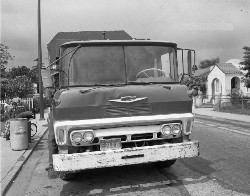
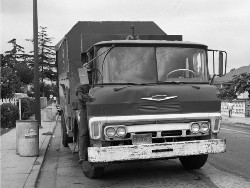
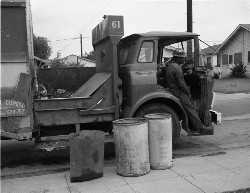
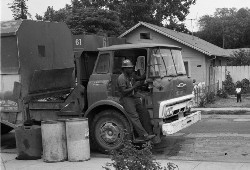
|
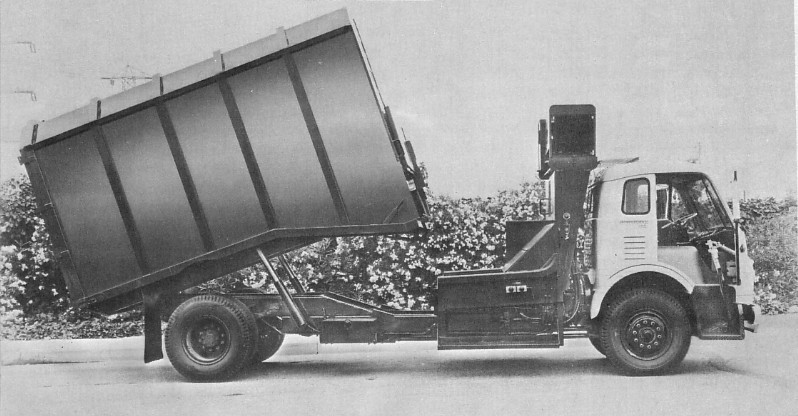
29-yard Shu-Pak on an International Harvester CO-series. Very early on, Shu-Pak changed their design so that the body split from the hopper for unloading. This resulted in better stability on landfills, and simplified the hydraulic plumbing.
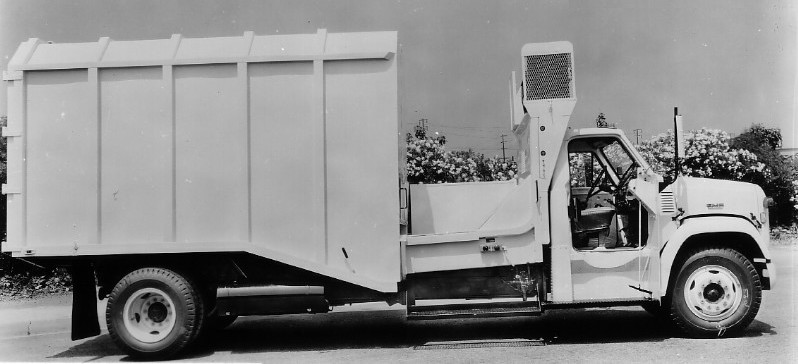
29-yard on a mid-1960s GMC HM-Series medium conventional
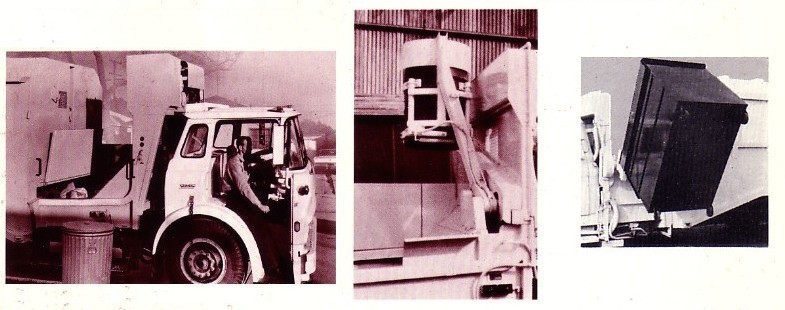
Optional features: (LEFT) crusher panel, hinged to the body which swings down to flatten bulky refuse and holds it in front of the packer blade. (CENTER) special hoist for emptying 55 gallon barrels. This was the system offered to, and rejected by the city of Scottsdale, Arizona, which led to the birth of their famous automated barrel-snatcher loader. (RIGHT) a side loading container hoist for special 1-2 yard wheeled containers.
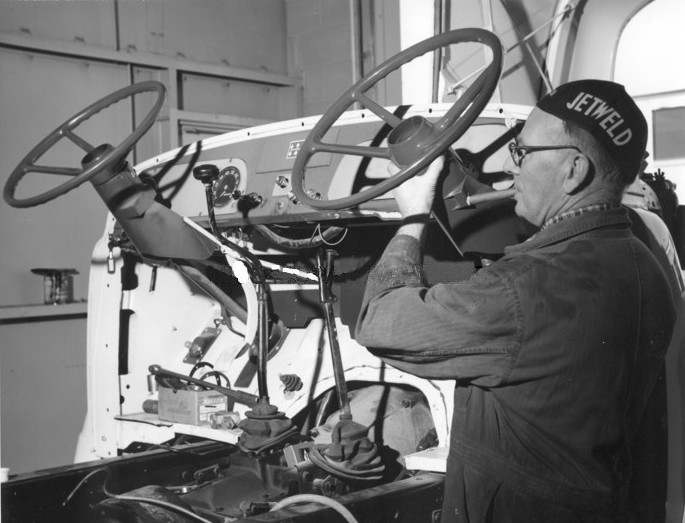
A mechanic is fitting a vehicle with dual controls. In this case, the truck manufacturer (such as International Harvester) supplies a rolling truck chassis with bodywork from the cowl forward only; everything else, including the windshield, is added by the body manufacturer or a third party shop. Other vocations that commonly use the "cowl forward" truck chassis are school buses, milk and laundry delivery trucks, and armored cars.
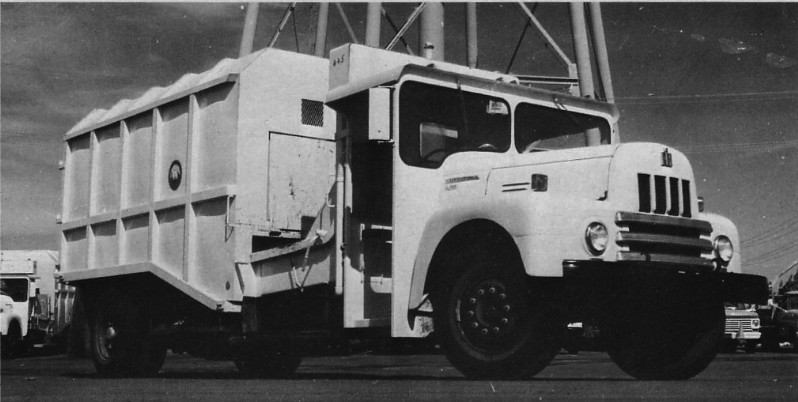
Above shows a finished truck, with an extra-wide, fully enclosed walk-in cab
|
SHU-PAK FRONT LOADER
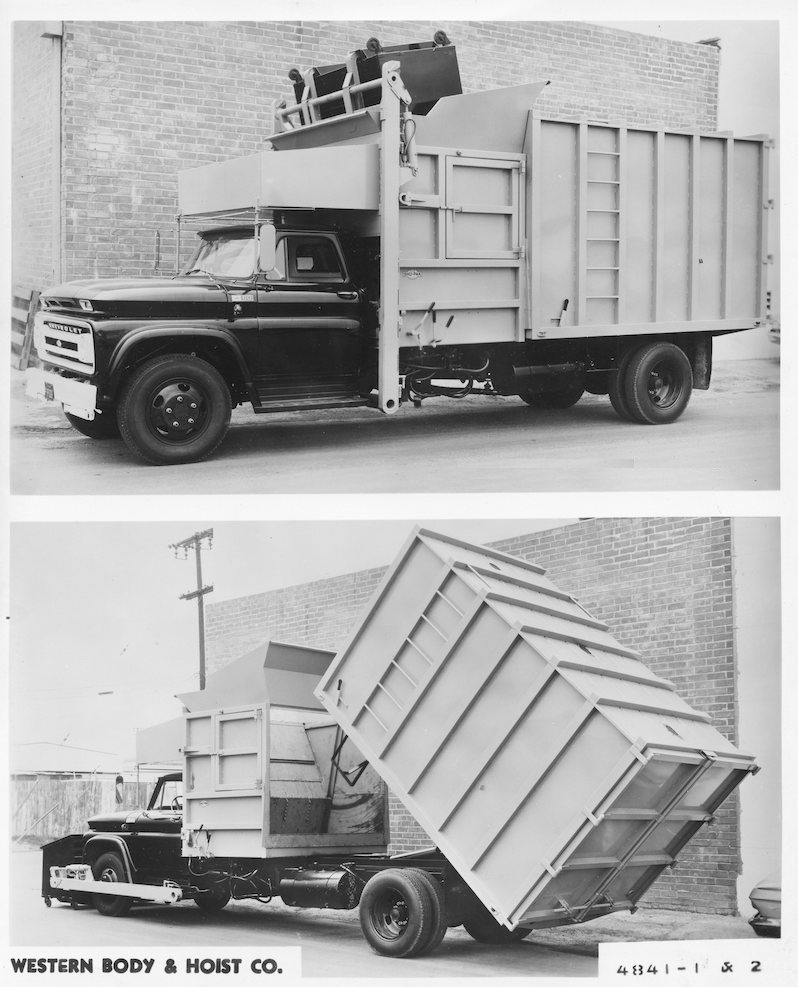
Shu-Pak patented a light-duty front loader, which was produced by Western beginning around 1965. These were straight-frame partial-packers with a swinging "pendulum" packer ram. Although fitted with side loading doors, these were primarily residential front loaders, although lighter commercial containers could also be mixed in the route.
With its blade suspended on links, the blade never touched the hopper floor, decreasing wear and frictional loads. Maintenance was as simple as greasing the pivot bearings and packer cylinder pins. A follower plate prevented refuse from building up behind the blade. The Shu-Pak front loader appears to have been short-lived, probably not surviving past the 1960s. Although Shu-Pak had an eastern licensee (TIFFCO of Toledo, Ohio), it is unknown if it was ever built or sold beyond the territory of Western Body & Hoist.
REFERENCES
U.S. Patent no. 2961105A, John M. Shubin, June 23, 1958 (Shu-Pak prototype)
U.S. Patent no. 3211309A, John M. Shubin, March 20, 1963 (Shu-Pak as built)
U.S. Patent no. 3325024A, John M. Shubin, June 4, 1965 (Shu-Pak front loader)
Classic Refuse Trucks: Bowles Load-n-Pack
Classic Refuse Trucks: Shu-Pak (Canada)
|



9/9/18
© 2018
All Rights Reserved
Photos from factory brochures/advertisements except as noted
Logos shown are the trademarks of respective manufacturers
|
| 





















